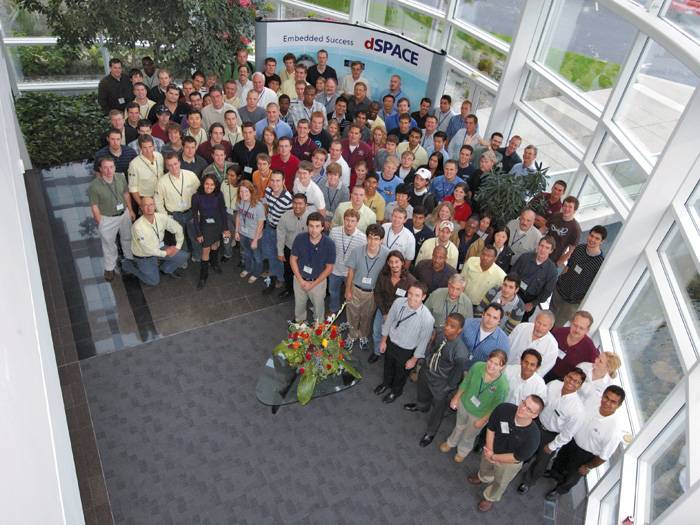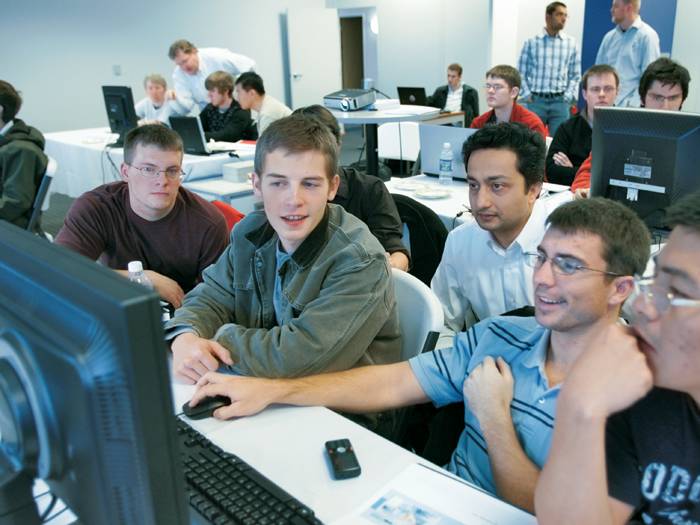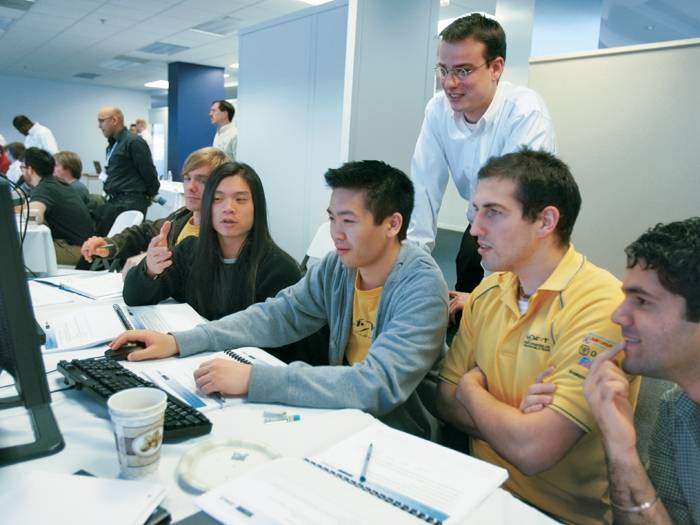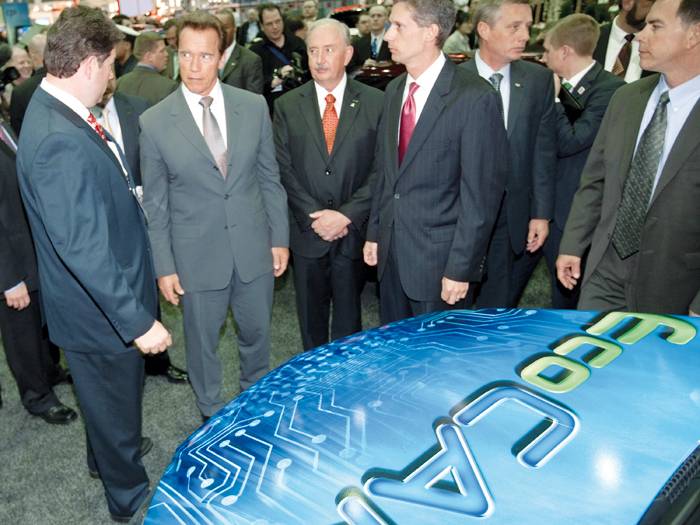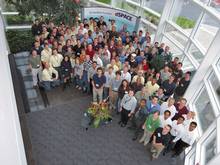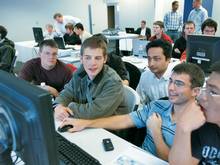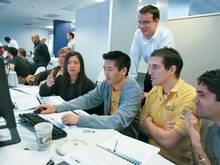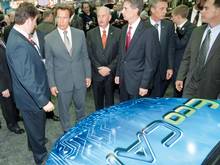EcoCAR: The NeXt Challenge Goes Green
Next Generation Automotive Engineers Develop Sustainable Mobility Technologies
For the EcoCAR Challenge the U.S. Department of Energy (DOE) assigned a three-year pilot project to 200 students from various universities. The teams must develop a productionready prototype vehicle and demonstrate the implementation of their “green” vehicle architecture.
Some of the world’s most original inventions can be traced back to the college campuses and research laboratories of the academic community.
It is within this environment – where students and faculty members can interact freely and exchange ideas – that technological innovation is born at a grassroots level.
Exploring and Developing Sustainable Vehicle Solutions
Since 1987, the DOE has sponsored 45 North American collegiate advanced vehicle technology competitions. The competitions, organized and managed by Argonne National Laboratory, a DOE research and development facility, have been highly successful. Past events have resulted in student- developed technologies for increased fuel economy, reduced petroleum usage, reduced greenhouse gas (GHG) emissions, reduced NOx emissions, and more. All of these technology areas are fundamental objectives for the DOE in its initiative to champion sustainable mobility.
Greater Performance for Green Power
In May of 2008, the DOE – along with sponsor General Motors (GM) – announced the onset of its newest competition – EcoCAR: The NeXt Challenge. Nearly 200 students from 17 North American universities were selected to participate in the threeyear competition, which kicked-off in August 2008 and ran through June 2011. Each participating team was challenged to re-engineer a 2009 Saturn VUE compact crossover SUV (donated by GM), with the following objectives:
- Reduce petroleum energy consumption on the basis of a total fuel cycle well-to-wheel (WTW) analysis
- Increase vehicle energy efficiency
- Reduce criteria gas and WTW emissions
- Maintain consumer acceptability in the areas of performance, utility and safety
In support of EcoCAR’s “green” theme, students must strive to achieve vehicle designs that meet California Air Resources Board (CARB) zero emissions vehicle (ZEV) regulations. Teams are encouraged to integrate lightweight materials, improve aerodynamics, and utilize alternative fuels such as ethanol, biodiesel and hydrogen.
Dedicated to Learning
University of Waterloo grad student Alex Koch says he is definitely up to the EcoCAR Challenge. Upon completing his undergrad degree last year, Koch received an attractive job offer, but he turned it down to pursue the university’s graduate program and participate in EcoCAR as team captain. “This challenge is as close as you can get to advanced vehicle development,” said Koch. “There are late nights and early mornings and it’s all driven by an underlying feeling that we (the students) are contributing to something big – something worthwhile – something that will make a difference.”
John Robbins, a computer engineering graduate student at Mississippi State University, concurred that the EcoCAR competition is highly valuable to students. “I absolutely enjoy every minute I spend on EcoCAR projects,” Robbins said. “The level of tools, technology, and training available are opportunities many engineers do not have access to and will open many doors for graduating students.”
A Taste of Real-World Engineering
The EcoCAR Challenge is funded and supported by a network of 30 sponsors who are providing money, hardware, software, training and support. Students are not only gaining access to state-of-the-art tools and equipment, but they are in direct contact with their sponsors who provide hands-on technical support and industry insight. The EcoCAR Challenge drives the exchange of technology and incites innovation through the establishment of student-industry partnerships with program sponsors. Additionally, to give students realworld experience, the teams are required to model their vehicle designs to the GM Global Vehicle Development Process, which includes stipulations for engineering practices, resource allocation and deliverables. Another aspect of the EcoCAR Challenge is focused on educating youth about engineering as a career path. Teams are encouraged to plan outreach events throughout the year to give students at all levels – elementary, middle, high school and college – insight into the field of engineering and its important role in developing innovation. Outreach efforts are also aimed at educating the general public about EcoCAR and technologies that support sustainable mobility. Even people in politics have become aware of the competition. California’s Governor, Arnold Schwarzenegger, made a surprise visit to the GM exhibit at the SAE World Congress to learn more about the EcoCAR Challenge. He spent some time listening to Kent Helfrich, Powertrain Executive Lead for EcoCAR and Director for Powertrain Software Engineering at GM, talk about the EcoCAR program.
Getting Eco-Friendly Vehicles Ready to Go
As a platinum-level sponsor, dSPACE has donated a suite of tools to enable students to develop and deploy advanced control strategies, simulation, vehicle integration and testing activities. Additionally, dSPACE has assembled a team of engineers to serve as dedicated technical mentors to the EcoCAR teams that are utilizing dSPACE equipment in their application projects. Tools donated by dSPACE include:
- MicroAutoBox/Rapid Prototyping Systems with ControlDesk (a graphical experiment management software program). These tools will be used as supervisory controllers.
- Mid-Size hardware-in-the-loop (HIL) simulators for testing new control algorithms.
- CalDesk for measurement and calibration of the dSPACE and non-dSPACE controllers.
- SystemDesk for planning, implementing and integrating complex system architectures and distributed software systems.
- TargetLink for automatic productionquality code generation.
Communication and Control via dSPACE MicroAutoBox
“I’m really excited that dSPACE is able to help EcoCAR teams by donating mid-size simulators and other tools to streamline our controls development,” said Koch. “The dSPACE simulator will help us to identify many issues that otherwise wouldn’t be noticed until the vehicle testing phase. The HIL will save us time, and many, many headaches.” Koch said his team is using the MicroAutoBox as the primary vehicle controller in their platform vehicle. “It will let us communicate and control all of the new hybrid power train components that we will implement over the next year,” he said. “The ControlDesk software, used with the MicroAutoBox, will definitely streamline our troubleshooting and calibration process and it’s extremely easy to use.” Robbins said the dSPACE HIL and MicroAutoBox have given his team the freedom to try any approach for controlling and simulating their vehicle. “dSPACE’s tools give us the ability to turn our ideas into experiments. This is exactly what we need,” he said. “Additionally, dSPACE training is top notch, and their tools are some of the best documented in the industry.”
Developing a Green Vehicle Architecture
Over the three-year duration of the EcoCAR Challenge, teams must fully design and develop a productionready prototype vehicle and successfully demonstrate the implementation of their chosen “green” vehicle architecture. During a press conference held at the Washington Auto Show, Washington D.C., in February 2009, the teams announced their chosen architectures. They will pursue Extended Range Electric Vehicles (EREV), Plug-in Hybrid Electric Vehicles (PHEV), Full Function Electric Vehicles (FFEV) and Fuel Cell Plug-in Hybrid Electric Vehicles (FCPHV). While these architectures represent different technology solutions, every vehicle design must:
- Have plug-in capability.
- Use state-of-the-art lithium ion battery technology, so the vehicles can store more electricity.
- Lower energy consumption.
- Use a renewable energy source that displaces petroleum consumption, which significantly reduces the amount of greenhouse gases emitted from the vehicle’s tailpipes.
- Have team architectures that retain the safety and real-world performance characteristics of production vehicles that consumers demand.
What Counts
Strong emphasis is being placed on using best-practices methodology and tools to develop control algorithms. Students will incorporate model-based development, rapid control prototyping (RCP), softwarein- the-loop (SIL) simulation, and hardware-in-the-loop (HIL) simulation. This environment will enable students to implement complex control designs quickly, and to test them early against real-time simulations before they are introduced to the actual vehicle. “Over the past two decades, we have seen a remarkable evolution in the sophistication and complexity of automotive technology,” said Kristen De La Rosa, Director of Advanced Vehicle Technology Competitions, Center For Transportation Research Argonne National Laboratory. “To stay industry relevant, the competition program has also evolved dramatically, by utilizing the latest cuttingedge technologies and engineering practices. The dSPACE tools, for example, allow teams to develop HIL simulations of their vehicles where they can test and validate advanced in-vehicle hybrid system controllers before the actual vehicle designs are assembled.” During an EcoCAR Winter Workshop held in January, students received tools, equipment and training to ramp up performance modeling, control system design and simulation activities.
Making Eco-Friendly Transportation Usable
EcoCAR Competition Finals for the conclusion of year one activities were held June 7-13, 2009, in Toronto, Canada. A panel of judges assessed each team on their use of modelbased design tools to ensure the proper fit of components into prototype vehicles and the functionality of electrical, mechanical and software systems. The teams were also judged on how effectively they used SIL and HIL simulation to develop controls and subsystems and on their educational outreach efforts. The overall winner was The Ohio State University, followed by the University of Victoria and the Mississippi State University. All three winning teams used dSPACE’s hardware- in-the-loop and rapid prototyping tools. Other awards were made for the best design, the best technical report, the best presentation, and so on. dSPACE also presented its Embedded Success Award to three teams that designed their vehicles with dSPACE equipment. In years 2 and 3 of the EcoCAR Challenge, the teams will implement their vehicle designs through the build out of a working prototype vehicle.
- EcoCAR: The NeXt Challenge Goes Green Reports, PDF, English, 743 KB
Drive innovation forward. Always on the pulse of technology development.
Subscribe to our expert knowledge. Learn from our successful project examples. Keep up to date on simulation and validation. Subscribe to/manage dSPACE direct and aerospace & defense now.

